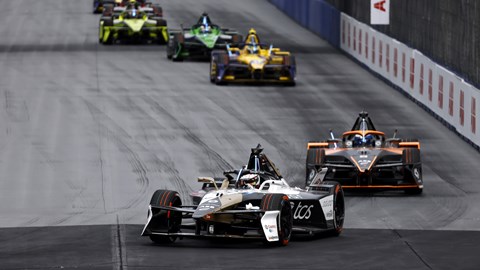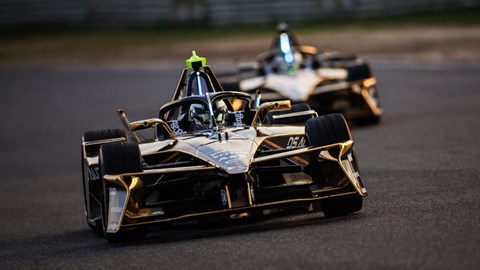► Formula E gets some big rule changes this year
► The new car does 0-62mph in 1.8 seconds
► Four-wheel drive at times, with pitstops planned
Formula E now enters its eleventh season, but it could be the most interesting chapter yet. The cars may look relatively similar to those raced in the last championship, but underneath they’re very different. More power, four-wheel drive and fast-charging pitstops are just some of the new changes that will transform the sport from an electric also-ran to a unique spectacle in its own right.
To learn more about the changes, CAR spoke to Jaguar’s James Barclay, team principal of the current constructors’ champions.

What’s new?
Last year, the Gen 3 Formula E cars were able to generate 300kW (equivalent to 402bhp) in baseline race trim, and 350kW (469bhp) with using the sport’s Attack Mode. What’s that you ask? A Mario Kart-mechanism where cars must drive through a zone on track (always off the racing line) to unlock an extra 50kW (67bhp). Teams must activate this twice over the race distance, for a set amount of time decided before the race. Drivers can deploy it in two chunks, but they can decide how to split them before the race.
The Gen 3 Evo racers generate the same power as the previous cars, but they’re now able to send drive to the front axle when in Attack Mode, too. When combined with new stickier tyres from partner Hankook, the Gen 3 Evo cars have significantly more grip than before.

Barclay’s Jaguar team won the 2023-2024 teams’ championship with its i-Type Six racing car – but they’ve pulled out all the stops to make this year’s Jaguar Gen3 Evo car even faster.
‘We started the development, the ideation of this car over two years ago, and then started the program really in earnest just over 20 months ago,’ he told CAR magazine ahead of the first race. ‘We plan for a full step change with the view that the championship will be incredibly competitive.’
Change aplenty: the engineering changes for Formula E in 2025
With that in mind, Jaguar’s engineers have been at work refining and improving every aspect of the car they’re allowed to. ‘We’ve come up with a car which is all new in terms of our manufacturer permitted parts; so a new powertrain, new power electronics, new gearbox, new software and new suspension.’

The suspension philosophy has also had to change, with Barclay telling us that ‘switching to four-wheel drive creates a different approach in terms of the suspension dynamics.’
More power and more grip come with more variables. ‘Between a 300kW (402bhp) rear-wheel drive car to the 350kW (469bhp) four-wheel drive, there’s about two seconds from new to old tyre,’ he reveals. ‘And if you look at the 300kW old tyre versus 350kW new tyre, that’s nearly six to seven seconds a lap faster. So it’s massively faster at different phases of the race.’

Like F1, the increased performance also comes with increased management and new driving techniques to drive as carefully but quickly as possible. ‘Dynamically, the drivers are loving it, but you also have to think about not destroying tyres,’ Barclay reminds us.
‘You see really big degradation,’ he warns. ‘Now, it’s about managing tyres and managing your energy strategy.’
It’s a view shared by Jean-Éric Vergne, who partners with newcomer Maximilian Günther at the DS team this year. ‘We’re going to have to understand how the degradation is going to play a role, and also the new attack mode is going to bring something different,’ the Frenchman told us. ‘Obviously with the four-wheel drive, you might want to create a gap [after Attack Mode]. That was not the case last year.’

Pit boost?
So the Formula E race cars are faster for 2025, trickier to drive and demand more from the driver – and importantly the difference in performance between cars has the potential to be huge at different parts of the race. ‘I think you’ll see a big push from the cars on Attack Mode,’ Barclay agrees. ‘They’ll be making lots of positions, maybe at times, trying to make too many…’
But it wouldn’t be Formula E without a new gimmick, only this time it has actual real race-to-road relevance. During selected races, Formula E cars must now receive a 10% battery recharge at 600kW. It’ll take approximately 30 seconds and should open the overcut and undercut strategies commonplace in Formula 1. At the time of writing, it’ll take place in the second race of double headers
‘It’s going to involve a lot more strategy for the teams and the drivers to manage,’ Barclay admits. ‘It’s another change this year which definitely resets the playing field. New cars, and now new race strategies, that we must try and be the best at.’
Round 2 of the Formula E world championship takes place in Mexico City on 11 January 2025.